Flora and Ulysses: The Illuminated Adventure
by Kate DiCamillo & K.G. Campbell
Bibliography:
DiCamillo, Kate. Flora and Ulysses. New York: Candlewick Press, 2013. ISBN 9780763660406
DiCamillo, Kate. Flora and Ulysses. New York: Candlewick Press, 2013. ISBN 9780763660406
Plot Summary:
In this Newberry Award winning novel, Kate DiCamillo tells the tale of young Flora, a self-professed cynic living with her mother, a romance novelist, after the divorce of her parents. While reading comic books, she spies a young squirrel outside her window who nearly meets his doom at the hands of a vacuum cleaner. Flora saves him and then befriends him after it is revealed that this near-death experience has left him with super-powers. In these pages we also meet her father, left adrift after the divorce, her neighbor, and her neighbor's great-nephew, William Spiver (both names, please, and never Billy). Their story is told through both words and the clever illustrations of K.G. Campbell.
In this Newberry Award winning novel, Kate DiCamillo tells the tale of young Flora, a self-professed cynic living with her mother, a romance novelist, after the divorce of her parents. While reading comic books, she spies a young squirrel outside her window who nearly meets his doom at the hands of a vacuum cleaner. Flora saves him and then befriends him after it is revealed that this near-death experience has left him with super-powers. In these pages we also meet her father, left adrift after the divorce, her neighbor, and her neighbor's great-nephew, William Spiver (both names, please, and never Billy). Their story is told through both words and the clever illustrations of K.G. Campbell.
Critical Analysis:
Flora and Ulysses is a wonderful example of how realistic a fantasy book can be, and how that can add to the interest and engagement when it comes to young readers enjoying the text. Flora is a character that a lot of students can relate to; her parents are divorced and she has become a bit cynical and a loner because of it - preferring to read her comic books than to always deal with people. Then enters a second character, Ulysses, who is just as easy to love, even though he is a squirrel. The fact that he gains super powers adds interest and the fantasy element to the text - it also causes our protagonist to change and break out of her shell, which is an important theme in young adult literature.
The plot of the book is believable and fun, despite the fact that it obviously could not all happen as it is a fantasy book. Flora's life could easy be any of our young students (aside from the whole super hero squirrel side kick). She is a regular kiddo dealing with real life - the divorce of her parents and her cynical attitude. Not to mention her love for comic books and wishing that such things actually happened in real life.
One of the best elements of this novel, however, is the voice that DiCamillo is able to create for her characters. It is not often in young adult literature that we see a character (at least a protagonist) that is as cynical as Flora is throughout a majority of the book. She has been through a lot at her age, and it has obviously taken a toll on her. It gives the reader the chance to see her open up and soften as she saves and befriends Ulysses, which creates a wonderful universal theme in the midst of the silly story.
Flora and Ulysses is a wonderful example of how realistic a fantasy book can be, and how that can add to the interest and engagement when it comes to young readers enjoying the text. Flora is a character that a lot of students can relate to; her parents are divorced and she has become a bit cynical and a loner because of it - preferring to read her comic books than to always deal with people. Then enters a second character, Ulysses, who is just as easy to love, even though he is a squirrel. The fact that he gains super powers adds interest and the fantasy element to the text - it also causes our protagonist to change and break out of her shell, which is an important theme in young adult literature.
The plot of the book is believable and fun, despite the fact that it obviously could not all happen as it is a fantasy book. Flora's life could easy be any of our young students (aside from the whole super hero squirrel side kick). She is a regular kiddo dealing with real life - the divorce of her parents and her cynical attitude. Not to mention her love for comic books and wishing that such things actually happened in real life.
One of the best elements of this novel, however, is the voice that DiCamillo is able to create for her characters. It is not often in young adult literature that we see a character (at least a protagonist) that is as cynical as Flora is throughout a majority of the book. She has been through a lot at her age, and it has obviously taken a toll on her. It gives the reader the chance to see her open up and soften as she saves and befriends Ulysses, which creates a wonderful universal theme in the midst of the silly story.
Review Excerpts:
From School Library Journal: " An engaging mix of narrative text, comic sequences, and full-page illustrations, DiCamillo’s new work introduces Flora, a self-described cynic and fan of superheroes, and Ulysses, a squirrel with special powers."
From Publisher's Weekly: "Newbery Medalist DiCamillo and illustrator Campbell meld prose with comics sequences in a broad comedy tinged with sadness."
From School Library Journal: " An engaging mix of narrative text, comic sequences, and full-page illustrations, DiCamillo’s new work introduces Flora, a self-described cynic and fan of superheroes, and Ulysses, a squirrel with special powers."
From Publisher's Weekly: "Newbery Medalist DiCamillo and illustrator Campbell meld prose with comics sequences in a broad comedy tinged with sadness."
Connections:
This would be a wonderful book to teach the idea that fantasy books can still have a large sense of contemporary realism as well. This book could also help to teach many different kinds of figurative language in an English classroom; specifically personification when dealing with Ulysses.
This would be a wonderful book to teach the idea that fantasy books can still have a large sense of contemporary realism as well. This book could also help to teach many different kinds of figurative language in an English classroom; specifically personification when dealing with Ulysses.


















